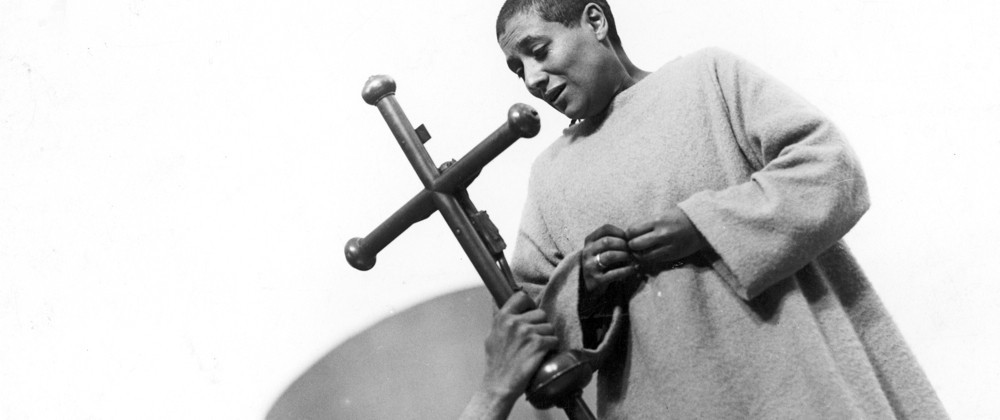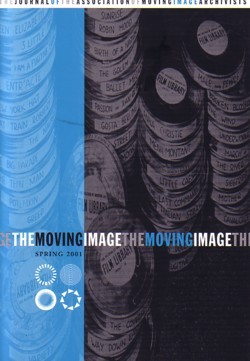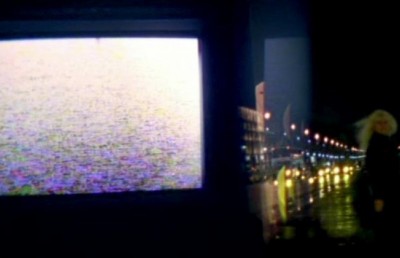AMIA: The Moving Image Journal
Film preservation journal

Given the timing of Jovanovic’s involved essay on the supposed demise of cinema I thought it would be appropriate to review a journal which I received over a year ago that represents an association whose aim it is to preserve cinema, the Association of Moving Image Archivists (AMIA). The title of their journal is The Moving Image, which was released in the Spring of 2001. The journal is published twice a year in the Spring and Fall, and they have currently released three issues with a fourth (vol. 2, no. 2) on its way. The journal functions as a mouthpiece for archivists, historians, researchers, curators, and academics who are interested in the vast area of film preservation (and more broadly, the notion of the moving image). I stress the notion of ‘vast’ because the issues surrounding film preservation really do cover a large canvas, as the articles presented in their flagship issue attests to. Here is just a sampling of the sort of issues that stem from film preservation: 1) the actual hands-on skill and techniques of film restoration; 2) the influence on the latter of changing technologies, especially the new challenges and gains of digital technology 3) questions of economics, which greatly influences the films that are chosen to preserve, which in turn impacts on canon formation; 4) the role of cultural institutes such as universities and museums; and 5) the discovery and rediscovery of National cinema histories.

Two essays examine the impact and importance of the film museum, which stands in some contrast to the film archive: Haidee Wasson’s "The Cinematic Subtext of the Modern Museum: Alfed H. Barr and MoMA’s Film Archive" and Alison Trope’s "Le Cinéma pour le cinéma: Making a Museum of the Moving Image." Trope discusses how film made its way into the museum. According to Trope, early film museum exhibits, borrowing from the science museum, highlighted the technological and scientific development of film history by showcasing everything from pre-cinema toys to cameras to film projectors. No sooner than film became legitimized as an art form in the 1930’s, it became fetishized as an ‘art object’ behind glass walls in the museum. The Benjaminian ‘aura’ once lost through technological reproduction became re-inscribed through institutionalisation. The bridge between the archive and the museum was started by Henri Langlois’ Cinémathèque Française (and later Musée du Cinéma). For cinephile and film collector Langlois, public accessibility to celluloid was as important as its preservation (and to screen or not to screen is still a hotly debated issue among film archivists, historians, collectors, and preservationists). As the film museum spread across major cities (Turin, the Museo Nazionale del Cinema, London, the Museum of Moving Image, Brussels, Cinémathèque Royale, Frankfurt, Deutsches Filmmuseum, Berlin, GDR Film Museum, New York, American Museum of the Moving Image) so do did its mandate to include social reform, entertainment, education, and pedagogy. No longer merely objects behind glass walls, the film museum now incorporates digital and computer technologies to feature interactive environments as an important component of the film museum’s entertainment and education agenda. As Trope writes, "The notion of aura that purists would link to celluloid and other cinematic artifacts, therefore, has and will continue to become progressively more obsolete as a combined focus on experience, interaction, technology, science, communication, art, and commodification of leisure takes precedence (56)."
Haidee Wasson conducts extensive empirical research to contextualize the rise of the first true American film archive, the film department at New York’s Museum of Modern Art. Wasson traces the museum’s rise in the early 1930s by concentrating on MOMA’s first director, Alfred Hamilton Barr, and how his Euro-centric preference for auteur masters (Eisenstein, Pudovkin, Dreyer, Bunuel, etc.) not only helped defray any fears the museum’s benefactors may have had about legitimizing what was seen, in the eyes of middle America, as a popular, commercial enterprise, but also set the tone for the film archive’s dedication to a polyvalent film art.
Up until 1912 films, unlike photographs, were not material covered under copyright laws. Things would change in 1912 with the Townsend Act. A substantial quantity of early American cinema was preserved due to a technicality in the copyright law which allowed early producers to submit their films to the Library of Congress as a series of single photographs which were contact printed onto a paper surface. This collection is known as the Paper Print Collection. Although much of the credit for restoring these prints goes to Kemp Niver, author Gabriel M. Paletz in his essay "Archives and Archivists Remade: The Paper Print Collection and The Film of Her" does historical justice by bringing to light information concerning an office clerk at the Library of Congress, Howard L. Walls, who in fact discovered the paper print collection before Kemp in 1939, and pushed for its restoration in 1942. Paletz goes on to discuss the differences between orthodox history of the Paper Print Collection (the great man theory, technological determinism) and the variegated factors behind the Print’s history.
The journal also includes an exemplary account of in-depth individual text analysis, T.A. Kinsey’s "The Mysterious History and restoration of Dreyer’s The Passion of Joan of Arc." Kinsey negotiates the layers of fact concerning the many different versions of the film that exist, tracing the lineage from cuts made to the film as a result of censorship problems in France straight through to what some scholars see as the original version of the film, the "Oslo version," and its subsequent digital restoration on DVD by Criterion.
Patricia R. Zimmermann’s essay on amateur films attempts to challenge the notion of a neat history where established professional filmmaking is separated from its non-professional brethren on its superior technical and financial merits. According to Zimmermann, amateur films should not be seen merely as the ugly or poor flip side of Hollywood and National cinema, but as an incredibly varied register of filmmaking which gives voice to those excluded from the ideological and institutional fortress of professional film. Zimmermann believes amateur films can be seen as micro histories versus what she calls the "nationalized phantasmatic representations" of major narrative filmmaking. Zimmermann has already dedicated a book to this subject, Reel Families: A Social History of Amateur Film, published six years before this essay in 1995. Unfortunately, Zimmermann’s straightforward and commendable subject is burdened with an academic-speak which continually attempts to add intellectual weight at the expense of clear writing. She seems to go to great pains to justify the social importance of amateur films by couching the central idea in unnecessary jargon, perhaps because of the subject’s lack in other areas (style, aesthetics, entertainment, etc.). As an example of this at times trying writing:
Amateur films as visual texts operate as traces rather than evidence, as visualizations and condensations of historical contradictions that rewrite the nation and the national imaginary as an imaginary process of signification that is always forming, changing, rather than inert and mythologized.
…On the historical level, amateur film represents the visual equivalent of diaries and dreams; indeed, more than factual records, they are psychic tracings. These films function as anthropological evidence, as social evidence of the micropractices of ideology, and even as political evidence of how the political was amputated from the subjective. But even more than that, these amateur films serve as psychic imaginaries where the nation, the family, dreams, nightmares, other countries, other races, the future commingle into new hybrids that border and define the nation differently.’ (112)
It is also ironic that for all of Zimmermann’s emphasis on non-conventional cinemas, she employs a rather conventional methodology for her three case study films by relying on close formal analysis and textual-thematic interpretation to ‘prove’ how the amateur films reflect an "invisible" history.
A more successful melding of the academic with the curatorial is Brian Taves’ discussion of how genre theory has been adopted by the archival field. In "Toward a Comprehensive Genre Taxonomy" Taves begins with the fact that the new generation of film studies trained archivists have incorporated genre theory into the methods used by researchers to access information on films. One result is the recent creation at the Library of Congress of the Moving Image Genre-Form Guide, which allows researchers to locate specific films according to genre. Taves examines the Guide and highlights some of the theoretical issues concerning genre that it raises. To begin, there is no consistent manner in which the genre idea has been employed, but a summary would divide genre according to the purpose to which it is being used. For example, how a video store or film studio groups together their films will have little relationship to how an academic groups films. In general, for the former genre serves an immediate function of helping to sell or market a product and can change according to the whims of the marketplace. For the academic, genre is a critical and historical term, with established precedents that must be considered before a change is put in place. Tom Gunning distinguishes these two genre understandings as "critical term" and "industry term." 1
The task of the committee in charge of coming up with the terms used in the Moving Image Genre-Form Guide, chaired in fact by Taves, was to sift through the hundreds of books and articles written on genre and come up with a taxonomy which could be best used by archives and libraries to make their holdings easily accessible to potential researchers. The end result was something that best fused the academic and archival worlds. Anyone interested in genre theory would appreciate the work down by this committee and I urge you to visit their web site and peruse through the exhaustive genre taxonomy, which not only includes sample titles but a succinct definition of each genre.
The journal also includes an annotated filmography of black and queer films by Bill Stanford Pincheon that identifies 180 films which feature a substantial contribution by black gays or lesbians and/or representations thereof. The article contextualises the author’s project, which stems from his doctoral work, and concludes with complete credits, plot synopsis and distribution information for the 180 films (features and shorts).
A "Forum" towards the end of the journal features two personal accounts by AMIA president Sam Kula and journal editor Jan-Christopher Horak, and an appreciation of the visual style in the Chinese films of the Lianhua Film Company by frequent Offscreen contributor, Professor Peter Rist. In "Mea Culpa: How I Abused the Nitrate in My Life" Kula reminisces about the trials and tribulations of flammable cellulose nitrate film (until the changeover to the acetate based Safety Film in the late 1940s). There is no doubt that nitrate film was highly flammable, and there were several instances of fires to prove it. But if nitrate film was so ‘dangerous’, Kula wonders why were there not more fires? Kula describes the circumstances behind several of these fires and demonstrates that in fact they were a result of negligence, ignorance or carelessness on the part of projectionists and/or theatre owners. Kula’s admission on how he "abused nitrate" comes at the end, when he notes that a good deal of the alarmism concerning nitrate was self-promoted by archivists in the hope that the urgency would help attain precious government funding to preserve and transfer nitrate films to safety stock. He sheepishly apologizes for showing up at FIAF (International Federation of Film Archives) one year with a button that read, "NITRATE CAN’T WAIT." As Kula notes, much more of our cinematic past has actually been lost due to studios deliberately destroying films because they did not see any profit in conserving them (pre-television), than due to fires or decomposition.
Horak’s piece, "The Dreamer: Remembering James Card", is a personal reflection of the founder of the Film Department at Eastman House, which reveals the idiosyncratic Card with warts and all. The reminiscence is an entertaining portrait of the determined film collector. Although big-time collectors like James Card often moved in secretive and illegal circles, a great many ‘lost’ and rare films have been preserved for future generations thanks to their efforts. Although Horak is thankful for the advances in film preservation made by the younger generation of academically trained archivists (of which he is a part), he also understands the contributions of older film collectors and how their illegal and at times underhanded methods enriched film culture forever.
Outside of Kinsey’s essay on Dreyer, all of the journal articles discussed so far have concentrated chiefly on American cinema. Professor Peter Rist adds a welcome non-American historical contribution to the journal with his piece on late silent and early Chinese film, "Visual Style in the Shanghai Films Made by the Lianhua Film Company (United Photoplay Service) 1931-37." For reasons that included the Japanese Occupation, the Second World War, and the Communist Revolution, early Chinese cinema was difficult to see and, consequently, overlooked by both Asian and Western scholars. According to Rist it was only in the 1980’s that early Chinese cinema had begun to be reevaluated. Instrumental in this reevaluation were major retrospectives of early Chinese cinema in 1982 (Milan and Paris), 1984 (Paris), and 1995 and 1997 (Pordenone,
The journal concludes with a relevant book, film and conference review section. As noted, the edition reviewed here was the first issue published in the Spring of 2001. The mandate set by the editorial board was admirably met in this first issue, blending a variety of methodologies, writing styles, and subjects, yet all related to the broad subject of film and image preservation. The table of content for the subsequent issues, as well as subscription information, can be accessed on The Moving Image journal web site. From what I gather from the lineup, it appears that the follow-up issues are as varying and stimulating in content as the first issue.
Notes
- Tom Gunning, “Those Drawn with a Very Fine Camel’s Hair Brush: The Origins of Film Genres,” in Iris n. 20 (Autumn 1995): 49-61. ↩






-resize-crop_400_258_90_s_c1.jpg)







